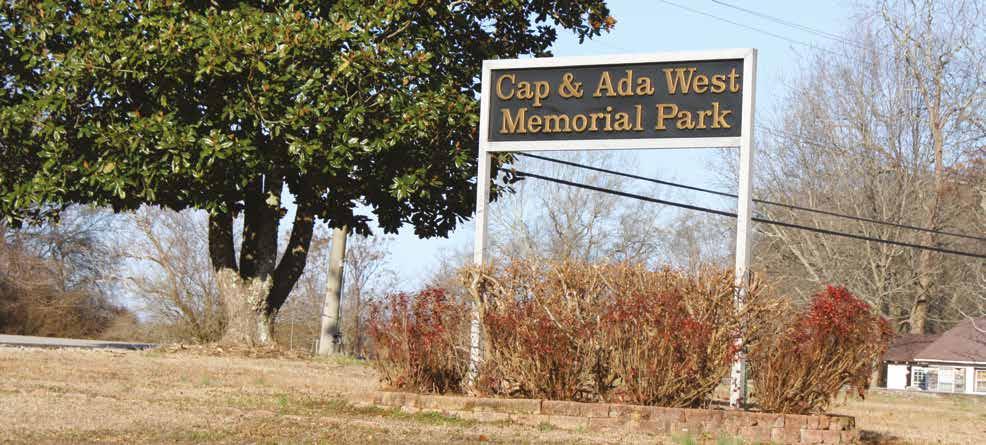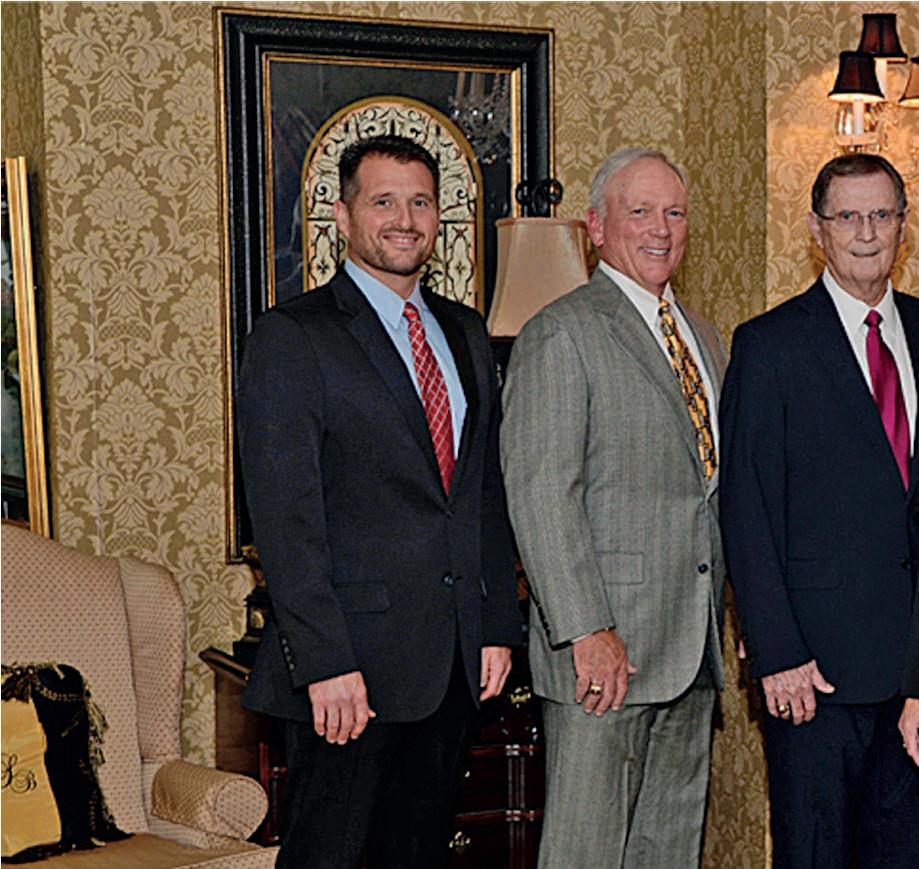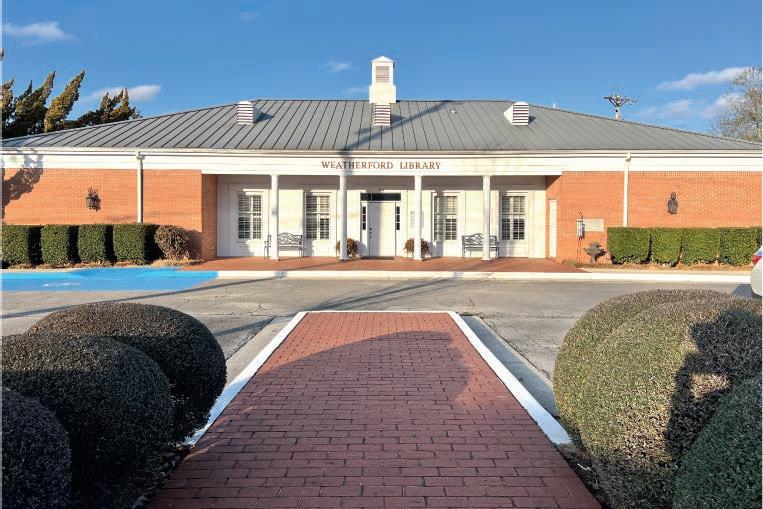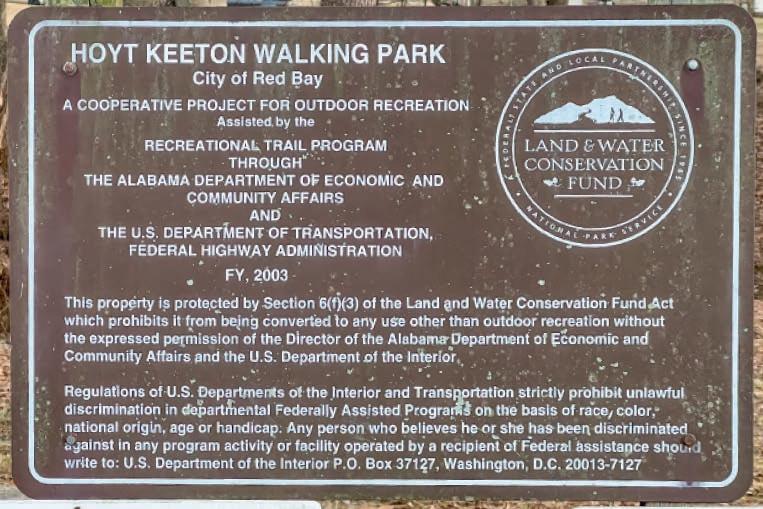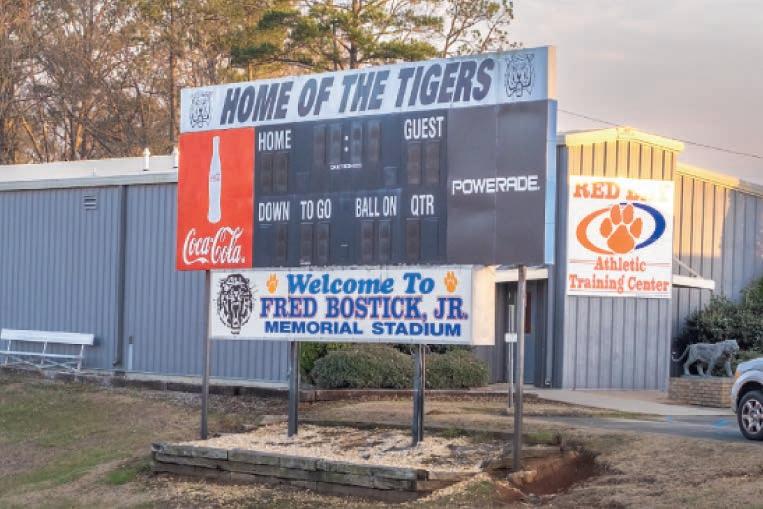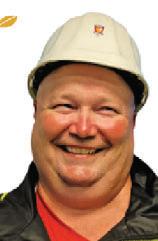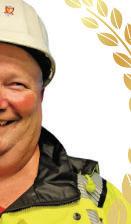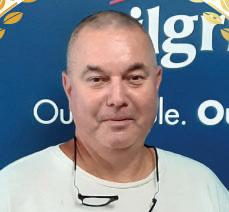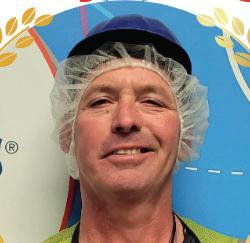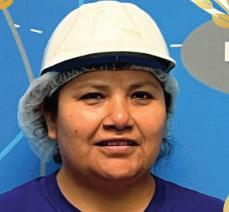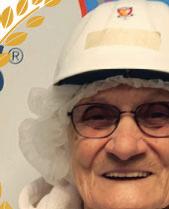

























Table of Contents





























What’s in a name?
This question was posed by playwright and poet William Shakespeare in “Romeo and Juliet” in the mid1590s, and it is one we have been asking ever since.
Although Shakespeare’s follow-up assertion that “A rose by any other name would smell as sweet” discounts the value of a name, we know the name of something can actually have a lot tied up in it.
When we meet someone new for the first time, what’s the first thing we tell them about ourselves? Why, our name. And how many times have you met someone, heard their name and immediately had a related comment or question? “Oh, Strickland! Now, are you related to so-in-so?” “I used to have a neighbor who was named Brenda.” “Morrison, now, we’ve got a bunch of Morrisons who live up our direction.”
The first thing most of us learn how to write is our name. Expectant parents agonize over what to name their children. We know each other and connect with our fellow man by name.
With that in mind, this year’s Progress edition is taking a look into the people whose names grace many of our local buildings and outdoor sites. Even lifelong Franklin Countians might not know the stories of these namesakes, and we want to make sure they are not forgotten.
These people will live on in this community thanks to the lasting contributions they made during their lifetimes – contributions that earned them a kind of recognition that can’t be easily overlooked, with their names emblazoned on buildings and signs across the county.
Who was A.W. Todd, anyway? Why is Red Bay Elementary’s playground named for Martha Ree Bostick? Who is Parrish Stadium named after?

If you don’t know, you’re about to find out.
Now, let me be clear in saying this issue of Progress is in no way a comprehensive list of every place in Franklin County named after someone. That would be nearly impossible. Time and page space would fail to represent them all – and even if we tried, we’d be almost sure to leave someone out.
Vina, for instance, was supposedly named for a train engineer’s wife –Elvina, nicknamed Viney, shortened to Vina. Hodges was named for a local resident, and Belgreen might or might not owe its moniker to a pretty young lady named Belle. Tharptown has Johnny Bull Tharp and his kinfolk to thank, and the community of Isbell can trace its name back to Ellis Isbell, an early settler who built a log cabin in the area about 1818. NorthwestShoals’ Glasgow Library is named for the junior college’s first president, and the sheriff’s office honors former sheriff Larry Plott. Franklin County itself is named after the esteemed Benjamin Franklin – “With the exception of Washington County, no County in the state was named in honor of a more illustrious American” asserts an article in the 1969 Franklin County Times Sesquicentennial edition. Additionally, roads all over the county bear the names of founders and former residents.
We do hope, however, that this edition of Progress will prove to be just a small tribute to the people whose legacies live on through the places named after them.
What’s in a name, indeed.
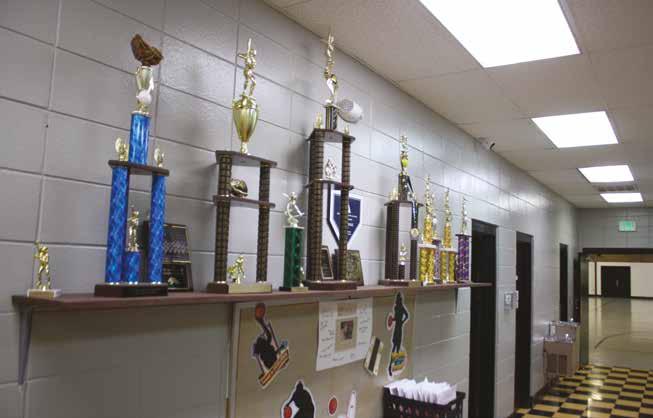
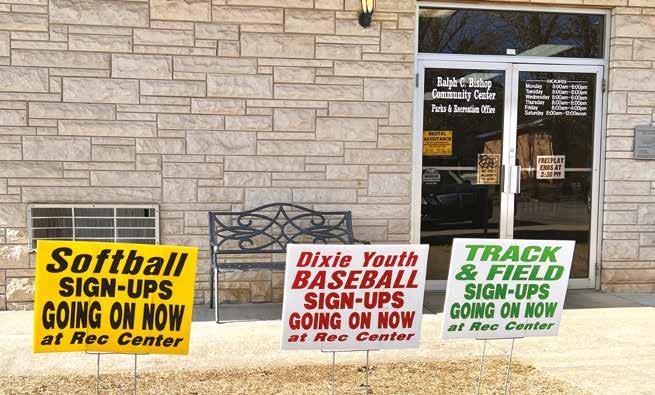
Ralph Clayton Bishop was born July 17, 1933 and died Feb. 15, 2000. In his 66 years he left his mark in the city of Russellville – perhaps most visibly as the namesake of the Ralph C. Bishop Community Center.
“Parks and recreation was organized under his administration, back in the mid-70s, and the park board was set up and a full-time director hired,” recalled Jackie Bradford, who served as the Parks and Rec director from 1976-2005. “He was all about recreation. He really got the department formulated in the early 70s, and it just blossomed from there.”
Bishop served one full term and one partial term as mayor of Russellville – from 1972-1976 and then again from 1984 to 1986, when he resigned to take the open position of electric board director.
According to city hall records, the Parks & Rec Board was created Nov. 5, 1973. Bids were received for the construction of what became the Bishop center Sept. 22, 1975. One bid from W.W. Dyar & Sons was received and rejected, and the council advertised for bids again. Oct. 20, 1975, a bid from W.W. Dyar & Sons was received and accepted at $136,000; a negotiated bid amount was accepted Nov. 10, 1975 for $116,000.
In a paid political advertisement in July 1984, Bishop’s campaign took the opportunity to assure the community he was “a good neighbor and an honest, God-fearing man. He’s also a good organizer, capable of making important decisions, and he’s not afraid of hard work. The last time he was mayor, his energy and know-how stacked up more firsts than our city has ever seen, including the first city budget, industrial park, fulltime fire department, sewer system, traffic study, and recreational center. Ralph has proved his heart and his loyalty are here.”
Following his service as mayor and electric board director, Bishop was appointed a U.S. marshal. He also served his country in the U.S. Army in Korea.
He was married to Dorothy Lee «Dot» (Caver) Bishop, who many remember fondly as a school teacher. He had two sons, Ralph Clayton Bishop Jr. and Christopher Lee Bishop, and four grandchildren: Clayton, Will, Noah and Olivia.
Bradford said although the community center was constructed during Bishop’s tenure, with funding Bishop helped procure, it wasn’t until later that the center was named for him.
“We just called it the community center for years and years, and finally the mayor and council renamed it as the Ralph Bishop Center,” Bradford said – “rightfully so,” he added. “It should have been named after him. I can’t think of anybody else they should have named it after other than him, for all the work he put in.”
Although today Russellville is served by two
community centers, the Ralph Bishop Center was the first – and only, for awhile. At that time as now it housed the Parks and Rec offices. The facility offers open play time for those wishing to use the gym as well as provides a space for organized rec sports. During youth basketball season, for example, it’s busy three nights a week, filled with young athletes and their fans.
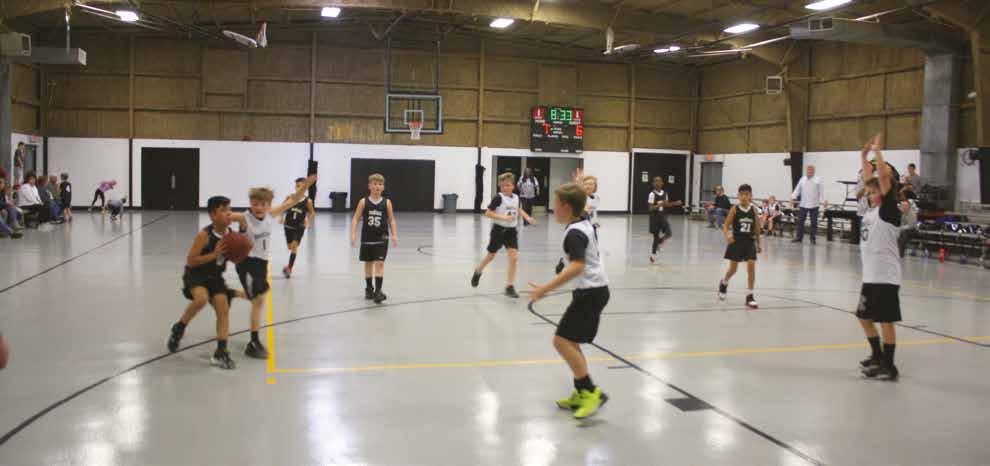
“Without it we just couldn’t have basketball leagues, and we also play volleyball,” noted current Parks & Rec director Donnie Flanagan. “We host a lot of programs for the children.” Flanagan said probably 700 or more children in the City of Russellville play one or more of the youth sports offered by the department. Pickleball will also soon be offered at the Bishop Center.

The center is also available for rent by the community and is often used by local civic groups – the Civitans meet there every Tuesday – and for adult programs.
“Recreation is birth to death,” Bradford pointed out. “We had Golden Gloves boxing up there. There’s been wrestling up there. There’s been all kinds of stuff.”
As to how Bishop would feel to see his name on the community center, Bradford just chuckled.
“You had to know Ralph. He was a character,” Bradford said. “He turned out to be a great friend. We went to Auburn games together … I got along with him real well. You knew where you stood with him. He was a man who, when he spoke, you listened to him. You know he was serious, and he meant what he said.”
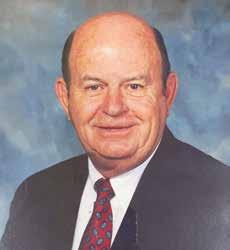
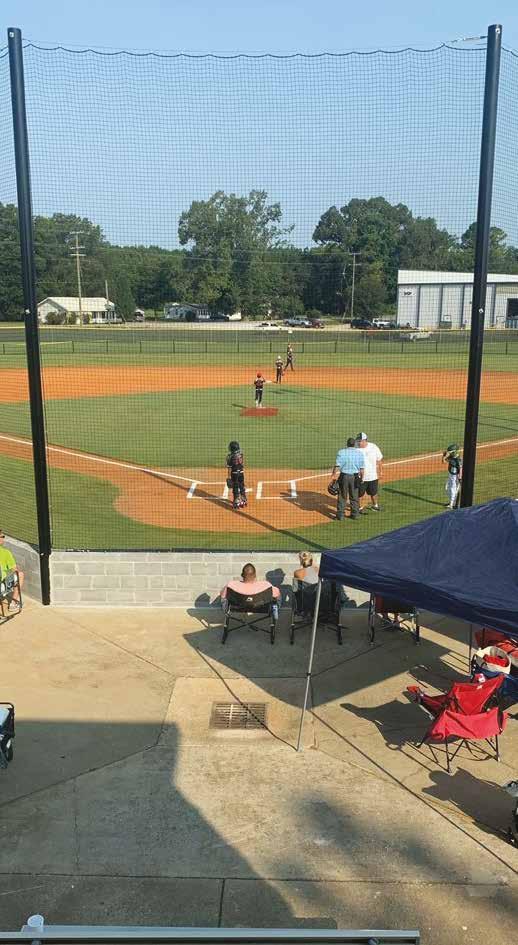 By Alison James alison.james@franklincountytimes.com
By Alison James alison.james@franklincountytimes.com
“John’s accomplishments are almost too numerous to mention, but regardless of the hats he wore with modesty throughout his life – coach, soldier, teacher and mayor – he took the most pride in being a husband, father, grandfather and friend.”
So reads the “Huntsville Times” obituary for John Blackwell – threeterm mayor of Russellville from 19882000, teacher for more than 30 years and namesake of the John Blackwell Outdoor Recreation Complex adjacent to Sloss Lake on Highway 24.
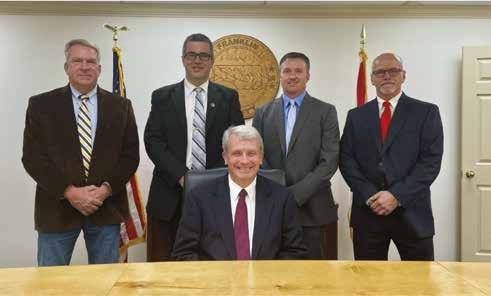
Jackie Bradford, who was Parks & Rec director during Blackwell’s tenure as mayor, said he well remembers when the mayor first proposed the idea of building some ballfields on that plot of land. The land was being given to the city by the Lee Apparel Company, which was formerly housed in the building that now belongs to IHP.
“I had been talking to Mayor Blackwell about (needing to build some ballfields) for a year or two, and finally he called me one day and said ‘Come by here. I’ve got something I want to show you,’” Bradford said. Bewildered, he joined the mayor, who took him over to the site that is now the John Blackwell Sports Complex. “He said, ‘I talked to the Lee people, and we can get this land.’
“There was nothing there except the lake,” Bradford recalled. As he and the mayor walked the plot of land, Bradford said he wasn’t sure about it at first. “It was hard for me to tell, just looking – you’ve got to have so much room,” Bradford explained. But architects went to work and brought a dream to life for youth sports in Russellville.
“It’s been really used since it’s been built,” Bradford noted, and indeed it has. The complex is always bustling with youth softball and baseball games during See BLACKWELL, Page 8
the spring season. Current Parks and Rec director Donnie Flanagan said some 700 children play one or more youth sports in Russellville.
The ballfields were first called the Lee Complex, after the company that donated the land. In 2009, then-mayor Troy Oliver proposed a name change.

“Mayor Oliver stated the next matter of business was long overdue and concerned naming the Lee Complex after Mayor John Blackwell,” according to the July 13, 2009, city council minutes. Oliver noted, “Mayor Blackwell had been instrumental in the development of the Lee Complex as well as the land on the east side of Sloss Lake.”
A motion to rename the ballfields was unanimously approved by the council.
“I thought that was a great idea because he was the one who found the land and obtained it so we could build the complex,” Bradford said. “For a little town like Russellville, it’s very nice. It could have been bigger, but at the time that was all we needed – we thought.”
As Blackwell’s obituary records, his “dedication to his community, county and the many people he called friend can be seen through his service and accomplishments as a member of the Russellville University and National Community.

“John retired from military service after 39 years of active duty as an officer and served three overseas tours of duty in China, Japan, Korea and Panama.”
He earned his Bachelor of Science in biological sciences from the University of North Alabama and a master’s degree in secondary education at UNA before pursuing his doctorate in supervision/curriculum development from the University of Alabama.
He passed on what he had learned as an educator for more than 32 years at Northwest-Shoals Community College, Athens State College, Bessemer Technical College and in the Russellville City School System. He also served as a member of the President’s Cabinet at UNA and was a founding member of the UNA Sportman’s Club, according to his obituary.
This is all among many other accolades and achievements, including president of the Russellville Rotary Club, VP of the Franklin County Arts and Humanities Council and chairman of the Russellville Hospital Board, among others. The Franklin County Chamber of Commerce awarded him the Hall of Fame Award in 2001, and
he was named Franklin County Citizen of the Year in 1992. He was a member of the Washington Avenue church of Christ.
He and wife Corinne Butler Blackwell, who is about to be 95 years old, had one daughter, Denisha.
“He was kind, generous, hilarious – yet strict,” Denisha said, reflecting on her father and his legacy. “He was a doting, loving father but also a football coach and the company commander of the local Guard unit. So he had to be a little bit of both.”
She said one regret is that her father didn’t get the chance to see the fields named in his honor, as he had passed away in 2005. She and her mother were both present at the council meeting when the resolution was approved.
“He would be very, very honored. He loved sports, and he loved Russellville. Russellville was his adopted hometown,” she explained. “He would be honored children are getting the opportunity to play in such a fine facility.”
Though she lives in Trussville now, Denisha said she makes time to drive by the complex whenever she is in town. It’s always a bittersweet moment.
“We’re very appreciative that the park has my daddy’s name on it. If anything was going to have his name on it, that is the perfect place,” she said, adding, “Daddy genuinely cared about people.”
Bradford said seeing Blackwell’s name on the complex is a welcome reminder of his friend, as with the other sports complexes in Russellville.
“They all meant something to me – Hal Kirby, Chucky Mullins, Mayor Bishop, Mayor Blackwell. They all did.”
When those Friday night lights go up in the fall, the Red Bay Tigers have a nice place to call home thanks in large part to the efforts of Fred G. Bostick Jr., for whom their stadium is named.
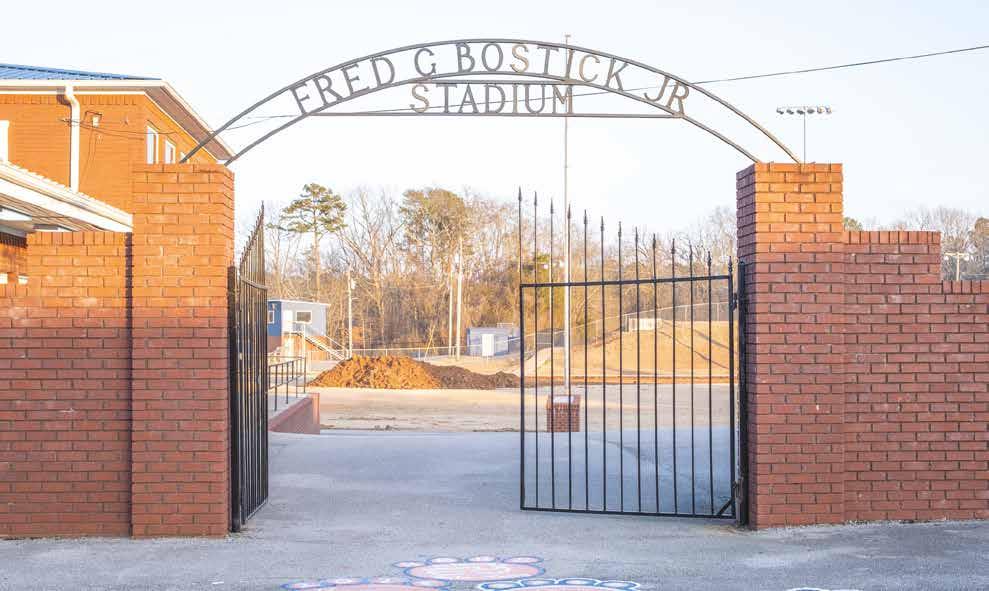
Bostick, who helped found Sunshine Mills with his father-in-law Omer J. Bullen, was “a no-nonsense kind of guy,” according to his son John Bostick. “He liked things done, and he liked things done correctly, and he liked things done quickly,” John added.
The elder Bostick was a decorated veteran of World War II, having served in the 9th Army in France, Belgium and Germany and having participated in the Battle of the Bulge. The one-time sergeant took his military discipline back into his civilian life.
“He gave out orders like a sergeant, and he liked them followed – 24 hours a day, seven days a week,” John said. His father would take nothing from anyone – for instance, one time when he was touring Red Bay High School with then-superintendent Bill Moss. “He came back from the big war smoking Lucky Strikes, and he smoked them nonstop,” John explained – including during that visit to RBHS. “The hall monitor came up to him and told him he couldn’t smoke there. He said, ‘You mean, you’re not supposed to smoke here,’ and he just kept walking down the hall,” John said with a laugh.
John, who is retired from the family’s Sunshine Mills, said he remembers vividly the day his brother Alan Bostick, president and Sunshine Homes, called him with some news.
“He said, ‘We’ve got a situation, and you’re not going to like it,’” John recounted.
Come to find out, the elder Bostick had done a little
off-roading. “The school kept the stadium gate unlocked and let people from Red Bay go in and walk on the walking trail,” John explained. “One day my day was up at the school, meeting with superintendent and principal on some topic, and afterward he just drove in and went around the track in his vehicle.” Seeing the state of the facilities at the time, Fred marched right into Alan’s office and said, “The football stadium won’t do. There’s nothing been done to the football stadium in 25 years, and it just won’t do.”
At that point, the younger Bosticks were on the hook. John took charge of renovating the visitors’ side and press box, and Alan took the home side and the concession stand. The stadium was soon newly renovated – and, not long after, named in Fred’s honor. It was after his death in 2001.
See
“He would be pleased that his buddy Bill Moss had named it after him. He would be pleased,” said John. “He’d been a big supporter of the school all his life.”

According to his obituary, Fred was a lifelong member of First United Methodist Church of Red Bay; an enthusiastic and loyal member of the Democratic



Mayor















community.
“This is their hometown,” said Fancher. “They’ve supported Red Bay, and they are part of the backbone of what makes Red Bay function. Throughout the years, they’ve contributed to not only our school system but to our city overall. When there was a need, they have helped meet that need throughout the years.”
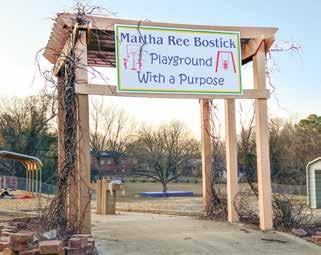 By Alison James alison.james@franklincountytimes.com
By Alison James alison.james@franklincountytimes.com
When people think of the name Bostick, they likely think of Sunshine Mills, Sunshine Homes and the efforts of Fred Bostick and sons Alan and John throughout the years. Behind every great man, however, is a great woman, as the saying goes, and people might not be as familiar with the actions of one woman who worked tirelessly behind the scenes.
“She was such a true role model for all of us and made such an imprint in the community,” explained Rosalyn Fabianke of her friend, Martha Ree Bostick. She described the Bostick matriarch as someone who “moved in quiet ways but had a dynamic spirit,” a “true example of not only a wonderful mother but also a heart for people and for Red Bay.”
Fabianke began a campaign to see the Red Bay Elementary School playground rehabilitated some 10 years ago, and she knew she wanted to see it named for Bostick. When daughter Harriet Bostick returned to the Red Bay community three years ago, she found the playground in disrepair and took up the charge to be part of upgrading it for the coming generations.
“Dr. (Jacqueline) Parsons and I started working on it,” explained Harriet. They enlisted the help of Mayor Charlene Fancher and the City of Red Bay, and big plans are in the works for the playground – along with more aesthetic upgrades, like the Peanuts-Inspired mural painted by retired FACS teachers Sherry Hutcheson this past year.
Harriet said Fabianke, who she called “an outstanding person,” and her mother went to church together at First Methodist of Red Bay, and “I guess it was apparent we
needed something named for Martha. She was really the power behind the throne,” Harriet explained. “She was community-oriented, and she loved children. She was the rock of our family. She kept us all at work.”
Fabianke said the playground, as it continues to be upgraded and improved, will “be a powerful way for children to not only have fun but learn skills and enhance their creative abilities in the classroom.”

“My background is health and fitness, and I was just a volunteer mom at the school,” explained Fabianke, a member of the Governor’s Fitness Commission. “The main thing was to get children moving and active, not only for their physical beings but also to help them in the classroom.”
With the elder Bostick’s passion for children, having her name on the playground seemed a fitting tribute.
“She just had a vibrant spirit, and she was real involved in the Methodist church and did so many special things,” praised Fabianke.
“She was a big supporter of education and children’s issues,” Harriet agreed. “We were trained to believe in education. It was just part of our growing up – to always support the school.”
Harriet noted the “Playground with a Purpose” is “one area in the school that is visited by over 400 children every school day. It needs to be top-notch for our elementary children.”
Enhanced safety and additional, newer playground equipment are a big focus. “The need is great, and they love the playground,” Harriet said. “This spring we painted some, and we have a little more equipment, and they just love it … Children are enthusiasts, and if you give them any kind of uplift, they enjoy it immediately.”
Harriet, 75, said though her mother has has passed
away, she knows how she would feel to see her name on the playground. “She would be embarrassed. She was a behind-the-scenes person. She didn’t want her name on anything.”
Work on the playground continues, and Harriet is committed to the effort. “I don’t want to be singled out as the leader. This is a team effort, and we have a long way to go,” explained Harriet, who has continued to work closely with Parsons. “We’ve done some little things, but we need to do some bigger things. This is just in the beginning stages.”
“The delightful thing has been the way the community is so excited,” added Fabianke. “I think the playground will make an impact.”
Martha Ree was marred to Fred Bostick Jr., and they had four children – daughters Harriet and Jill and sons Alan and John.

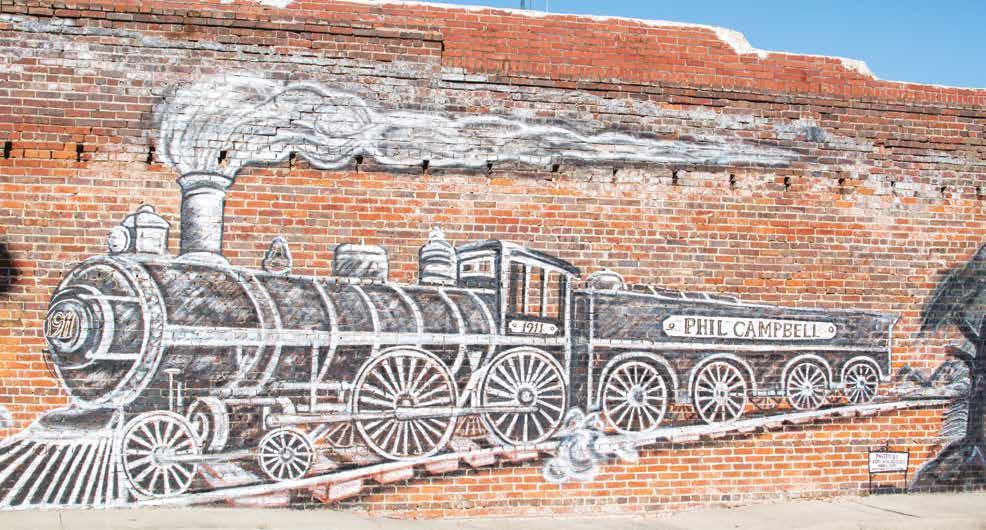 By Alison James alison.james@franklincountytimes.com
By Alison James alison.james@franklincountytimes.com
The history of the Town of Phil Campbell is extensive, but “Place Names in Alabama” by Virginia O. Foscue puts it pretty succinctly: “Named for Philip Campbell, the contractor who built the Birmingham, Sheffield and Tennessee River RR through this area in 1886. L.M. Allen, one of the first settlers, had promised to name the town for Campbell if the latter built a spur track and depot here.”
A February 1976 publication of the “Phil Campbell Reflector,” recounts how Mel Allen, “the area’s most prominent merchant,” made it a personal goal to have the railroad pass by the vicinity of his store, to build up a town in that location. Allen connected with engineer/ contractor Philip Campbell to make his dream a reality, with the interesting offer to name the town after the latter, if he made it happen. He reportedly “told Mr.
Campbell if he would build a depot and put in a side track” that he would name the town for him.
Phil Campbell is the only town in Alabama to have both the first and last name of a person. “So, Phil Campbell might have had an entirely different name if it had not been for the Allen family of Franklin County,” the “Reflector” surmises.
“I think that’s unique,” said Councilwoman Lynn Landers. Landers has, in the past few years, founded the Phil Campbell Arts and Historical Society in Phil Campbell, with an eye toward preserving the town’s history. “I don’t think we would be a town (without the railroad) – maybe a smaller community like Spruce Pine or Bear Creek. I think it actually helped put us on the map.”
It certainly did. The depot in Phil Campbell was a busy place. It had a waiting room, a ticket office and a freight room. The heat was coal in a “pot bellied” stove. There was a sand box around the stove to protect the floor but was used as a place to spit tobacco and snuff.
According to historical accounts, “all the cotton, cross-ties, etc. were shipped out on the R.R. All work of laying track, building bridges and trestles was done by hand by the men … Anyone going shopping, visiting, etc. went on the trains. Students that went to Florence Normal School (now U. of N.A.) went back and forth on the train.” A 2006 article in the TimesDaily newspaper records the railroad also transported “sandstone from Fern Quarry (near Littleville) and limestone from Rockwood (south of Russellville) to Sheffield.”
“Campbell was listed as manager of the railroad in newspaper ads dated 1894,” the TimesDaily article notes.
Campbell was born in Liverpool, England, in 1848. He is sometimes referred to as “Maj. Phil Campbell,” though the precise implication of the title is uncertain.
According to the “Reflector,” he did live in Phil Campbell for some years. He was also at one time mayor of Sheffield. He died in New Orleans June 30, 1932, at 84 years of age.
Landers said she hopes to visit his gravesite when she makes an upcoming trip to New Orleans. A photo of the site would be a good addition to the historical society’s memorabilia. The society is in the process of purchasing/renovating the former city hall in downtown as a facility to house memorabilia and display local art. Landers said the building has to be gutted, re-wired and re-plumbed, and it needs a new roof, but the society hopes to restore it to its former glory. “It’s going to take a while,” she added. The importance of the society’s mission, however, drives the progress. “Things get forgotten – especially by the young people of today. There’s a lot of things that are not on the internet, and this way they can just come into the building and see it.”
An old newspaper article, dated June 26, 1924, recounts an occasion when Campbell returned from New Orleans to the town bearing his name for a visit. He “was in the city last week to visit with his old friends here, among whom are Mr. C.E. Wilson and Mr. J.H. Walston, of the Wilson Mercantile Company. At the time the Major was building the railroad here he purchased many thousands of dollars worth of goods from the Wilson company and became warm personal friends of Mr. Walston and Mr. Wilson. At that time
Today Phil Campbells from all over the world celebrate an affinity for the town that shares their name, but it all started with this Phil Campbell. The town’s namesake built the railroad through the area at the behest of Mel Allen, a prominent merchant in the area in 1886
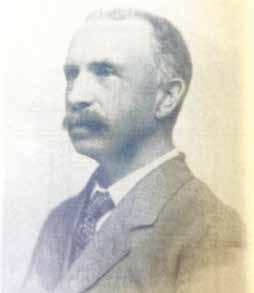
The Phil Campbell depot is pictured in a photo printed in the “Phil Campbell Reflector” in 1976. It was once a hub of the community. “All freight came in by rail – also the mail. There were four passenger trains each day – one early in the morning – one at noon – one at 3 p.m. and one at 9 p.m. The roads were dirt roads so the traveling salesmen (or drummers) came in on the trains and spent the night at a hotel near the depot.”
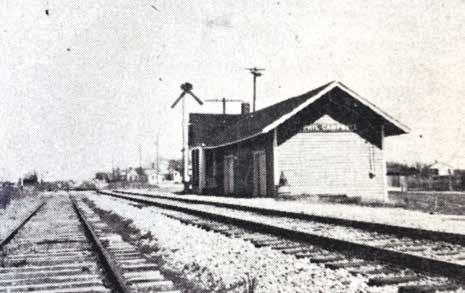
Russellville was just a small country village. Maj. Phil Campbell was in complete charge of the railroad at that time. His old friends here were glad to see him in our city again.”
Today the railroad is owned by Norfolk Southern, which “owns and operates a network of 19,500 miles of rail lines east of the Mississippi River in 22 U.S. states and the District of Columbia,” according to its website. The town was incorporated in 1915.
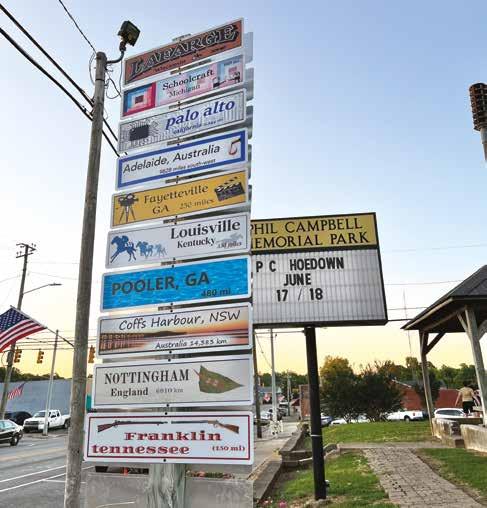
In the back corner of the Phil Campbell campus of Northwest-Shoals Community College, a distinctive sign marks the start of a unique outdoors space open to students, faculty and community members alike. The walking trail is named for Cecil Clapp, the forestry technician professor who, along with his students, first built the trail in the early 1970s.
According to a 2004 Franklin County Times article, the trail had fallen into disrepair by the late ’80s, when it was rediscovered by biology professor Joe Alls, who led the charge to have the trail restored.
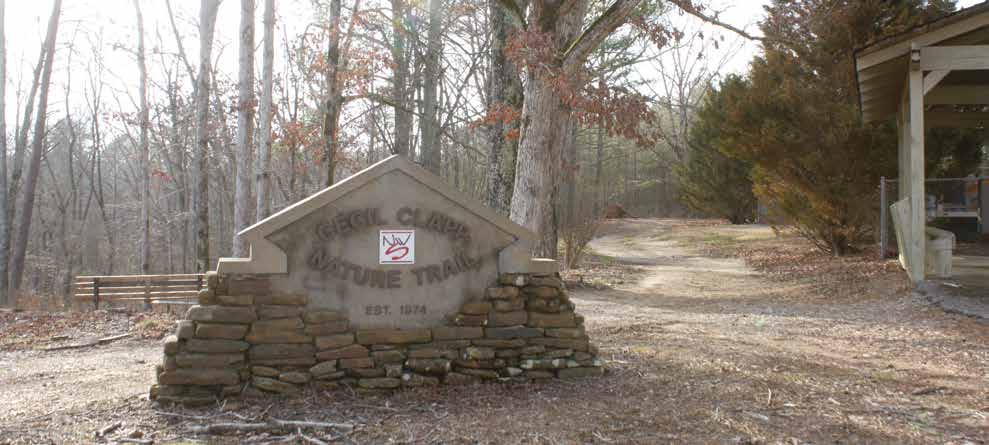
“I guess after Mr. Clapp retired in the late-70s, the nature trail and amphitheater were just neglected,” Alls said at the time. It took several years of pursuing different routes to rehab the trail, but Alls finally found the support he needed in Glenn Hudson, associate dean at the time. Alls joined with Jimmy Glasgow,
director of the Alabama Center For Advanced Woodworking Technology in May 2003, and by October of the same year, their efforts – along with those of other volunteers – had yielded a renovated trail. More than $43K was donated toward the work, with the school spending another $15K.

“It’s a beautiful place to study and learn,” Alls said.
The happy ending, however, was not to last. The 2011 tornados damaged much of the trail, and it would be some 10 years before it was restored again. NWSCC received $10,000 from the Northwest Alabama RC&D Council and $5,000 from the Alabama Power Foundation to restore the nature trail, and a ribbon cutting reopening event was held in April 2021.
Alls died in 2019, a year before the funding to restore the nature trail and outdoor classroom was acquired, but his commitment to Clapp’s original vision lives on, with the outdoor classroom named in his honor.
Restoring the trail and outdoor classroom included clearing trees and
debris off the trail, building new benches for the outdoor classroom and building bridges to access the outdoor classroom. The grand reopening included appearances from Rep. Jamie Kiel, Rep. Proncey Robertson and members of the RC&D Council and Alabama Power Foundation.
The trail is approximately a quarter of a mile long and features rock bluffs and native Alabama plants.
“Everything he did, he did it 100 percent and put everything he had into it … People respected him because he worked hard and put in so much effort and loved what he did.”
That’s how Pam Humphres remembers her father Clifton Franklin, a former Vina coach for whom – along with Granville Hester, another beloved Red Devil coach – the stadium is named.
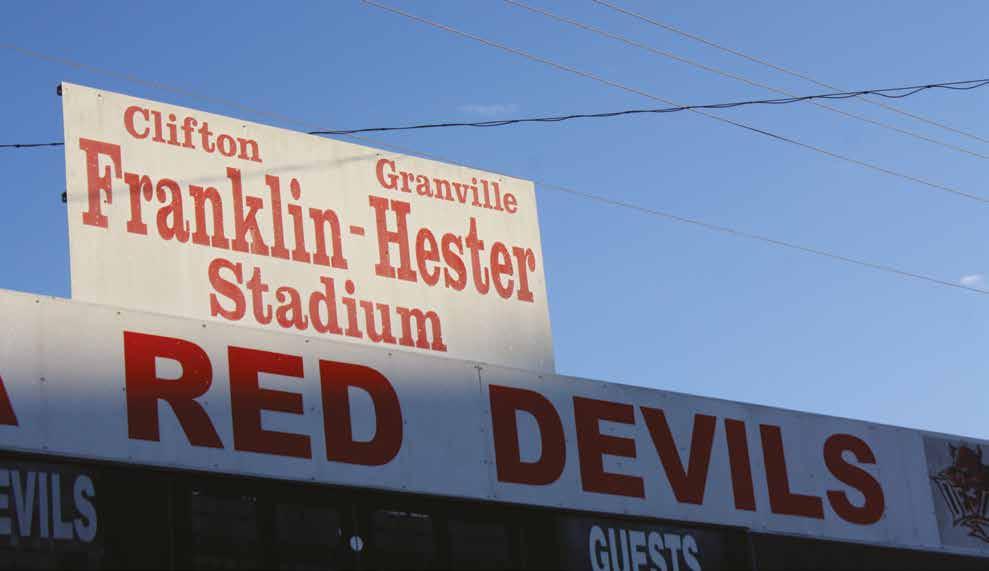
“I know he was honored that they would do that,” said son Ben Franklin. “He was always proud to be from Vina. He loved Vina and took a lot of pride in Vina.”
Clifton Franklin was a Vina coach for more than three decades, from the mid-1960s to the mid-1990s. Ben said he and his three siblings – Humphres, as well brothers Sam and Clifton Jr. – were all students
at Vina during their father’s tenure there. They had a front-row seat to his impact at the school, particularly on the football field.
“He had a lot of success,” Ben said. “I don’t think he ever had a losing season.” The Vina native and VHS alum taught government, history and driver’s education, but the game was his passion. “I think a football coach is pretty much all he ever wanted to be.”
The elder Franklin was in the Navy in the mid-50s, an enlisted man, working as a firefighter and in the engine room, by Humphres recollection. Following his military service he went to college on the GI bill, attending Itawamaba Community College – where he met his wifeto-be, Betty – before earning his undergraduate degree from the University of North Alabama. He earned his master’s degree in political science from Ole Miss.
“Above all, he was someone who really valued hard
work,” said Humphres. “He grew up on a farm where they plowed mules and had a really strong work ethic, and he carried that into coaching.” Ben said that work ethic could also be found in their mother – “She was always very supportive of him. She helped him in a lot of ways – taking care of things on the farm when he couldn’t be here and all those sorts of things” – and Humphres pointed out their father believed in hard work’s role in developing students and players. “He wanted to help people … The things he did were typically connected to helping other people.”
That desire did not go unfelt or unappreciated by the people the elder Franklin impacted during his life. Some two decades after his retirement in 1990, Humphres said she was inspired to host an event connecting her father to his former players. See
“I had went to a coach’s funeral, and everyone got up and was telling stuff about that coach, and I thought, ‘You know what? I want my dad to hear this – to know this before he passes away.’” She felt sure her father’s players would have their own stories to share about his influence in their lives – and she was right.
“She knew a lot of his former players thought highly of him, and she wanted him, while he was still able, to talk to them and be around him,” Ben explained. The event was held at the Vina Community Center, which filled to the brim with former players. “He loved seeing them and talking with them. He never forgot them … It was great that he got a chance to reunite with all those players before he got sick and died. He was a fatherfigure to a lot of folks. He served in that kind of role.”
Humphres said their father “always wanted to show those boys what was right not just in football but in life, and he helped so many of them.”
Ben said one of his father’s rules will always stand out to him: “You never walked onto the football field. You always ran,” Ben said. “He always ran, and he always expected us to run. You were disrespecting the game if you walked onto the field.”
It was an outgrowth of his commitment to hard work. “He’d always say, ‘They might be better than we are, but they aren’t going to outdo our hearts and our trying,’”
Humphres said. “He always put everything into it.”
The stadium was named for Franklin and Hester in 2001 following remodeling. Franklin was present for the dedication, as was Humphres.
“They called him on the field, and I think Granville Hester’s wife was there, and they made a presentation about the field,” Humphres said. “He was just thrilled. He was beaming that night.”
The elder Franklin passed away in 2016, leaving behind a legacy that won’t be forgotten by those who knew him.
“He always tried to emphasize that you should always do your best – not just at football but everything. Do it with everything you have,” said Ben.
“He loved what he did,” Humphres added. “He loved the school, and he loved the boys. He wanted them to be respected, and he wanted them to learn.”
According to VHS, Hester was a U.S. Army veteran of World War II, where he fought in the Battle of the Bulge and was the recipient of the Silver Star. He served as football and basketball coach at Vina High School in the 1950s, to great success. His son Randy Hester was a player for Clifton Franklin and was Vina’s school board member for some years.

The Vina facility also bears the name Johny Wayne “Chubb” Childers, with the field named for him.

At the back of the Red Bay Fun Park, running along behind the Red Bay Farmer’s Market pavilion and the popular water park area, an assuming paved path follows the edge of a creekbed. Lined with trees and red park benches, passing by a few picnic tables, the trail provides a peaceful place for citizens of Red Bay and guests to get into nature and enjoy a little exercise.
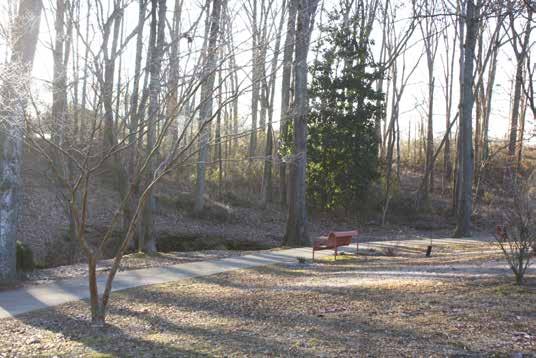
The trail came about at the urging of Hoyt Keeton, for whom it is named.
Son Hal, whose family owns and operates the Big Star locations in both Red Bay and Russellville, well remembers the many walk his father enjoyed taking during his life. His sisters Lisa Davis and Kathy Hale do too.
“Tommy Nelson said Daddy had always asked about a walking trail,”



Keeton explained. Nelson was mayor at the time, serving from 1996 until his death in 2005.
“Daddy loved walking. He’d take up with anybody who wanted to go walking,” Davis added.
“They got grant money and developed the walking trail,” Keeton continued, “and Mayor Nelson said it wouldn’t be right for it to be named anything else.”
Keeton said walking with a friend gave his father a captive audience. He loved to chat. Davis and Hale said he also had a focus on fitness.
“I went and walked with him up a lot around the high school,” Hale said. “He liked athletic stuff –football, softball, whatever.”
“He was always trying to be healthy,” Davis agreed. “He had it on his mind a lot.”
Hoyt Keeton was a Chevron gasoline driver in Red Bay, a job
See KEETON, Page 18
that carried him through retirement, starting in 1952. He also had convenience stores in the area. In 1989 he purchased the Big Star in Red Bay, and in 1992 he bought the one in Belmont, Miss. “His mother and dad were in the grocery business when he was kid,” Keeton explained. “They had Red Bay Grocery. It was in the days when they had live chickens, and they did more delivering groceries than they had people coming to the grocery store.”
The Keeton children said their father, who passed away in September 2007, would certainly be pleased Red Bay now has a walking trail for all to enjoy.
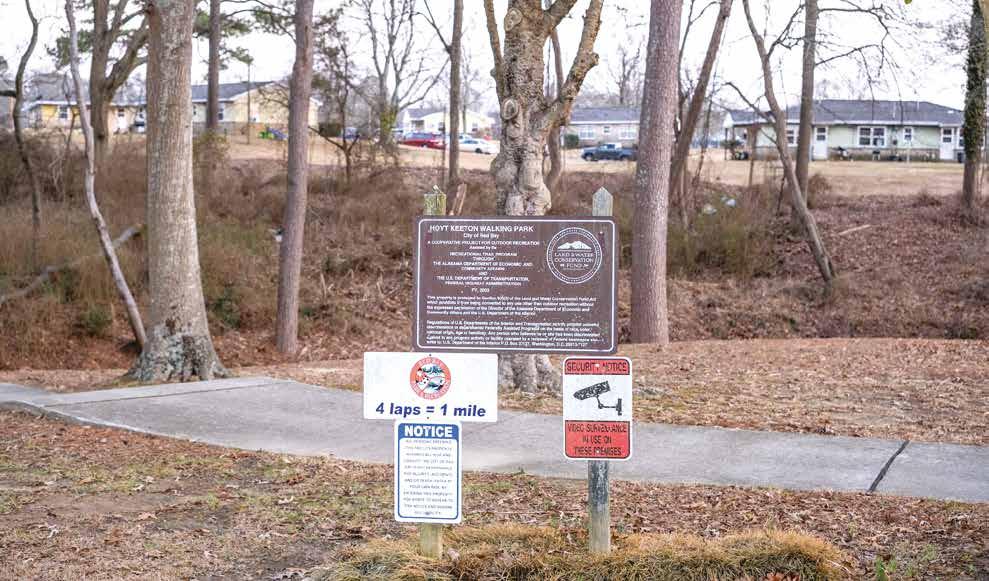
“I believe he’d be very humbled,” said Keeton. “He was just a humble person. He was a caring person – a loving person.”
“He loved everybody,” Hale agreed.
The elder Keeton predeceased his wife, Peggy Purner Keeton, who passed away in July 2021, and their children remember that although he enjoyed a good walk,

their mother did not. Keeton said he remembers Davis trying to encourage their mother to be more active, saying, “You know Daddy would want you to get up and walk and exercise. And she looked at us and said, ‘Well, it did him a lot of good!’” It’s a memory they share with a chuckle, recalling that the older she got, the more blunt she was about it. “But I know she was thrilled they named it after Daddy,” Davis added.
Keeton’s children, who also include older brother William “Butch” Hoyt Keeton Jr., said they hope people remember their father for the way he loved people and how he treated them.
“When I was 32, I had breast cancer, and I lost my hair, and he went and got his hair shaved off,” Davis said. “That’s just the type of person he was,”
“He was the type of person who was always there for you,” Hal Keeton added, “through the good times and the bad times. He never turned his back on you.”

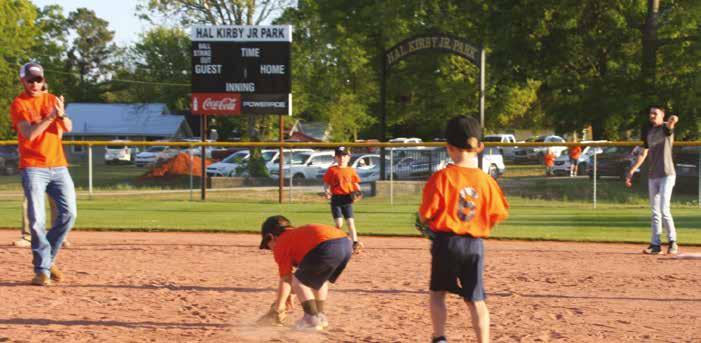
 By Alison James alison.james@franklincountytimes.com
By Alison James alison.james@franklincountytimes.com
Look back through the pages of history, and the name Hal Kirby is prominent at every turn. Chamber of Commerce president. Probate judge. Radio DJ. Agriculture Coliseum board member. The list goes on.
This is not, however, the man for whom the Hal Kirby Jr. Park is named. These fields, located on Underwood Road, are named for the elder Kirby’s son, who died from an illness in grade school.
“This fields have been named Hal Kirby Jr. for as long as I can remember,” said Jackie Bradford. Bradford was a classmate of the younger Kirby’s, and though he said he can’t recall exactly when Kirby Jr. passed away, he thinks it would have been when they were in sixth or seventh grade.
“Those fields have been here forever,” said Bradford, who became Parks & Rec director in 1976. “I played Little League over there.”
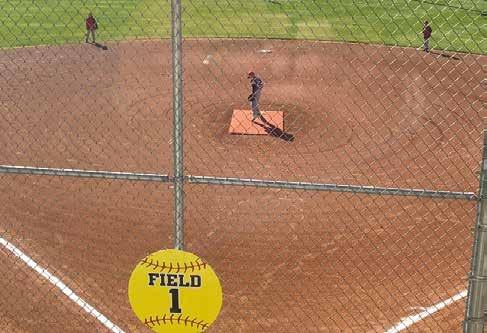
Of course, over the years the fields have been renovated, and a press box and concession stand have joined
what were once modest amenities. In 2015 the city received a $250,000 Community Development Block Grant to refurbish the park, which was severely damaged by flooding. The grant brought new fencing, signage, walkways and a multi-use building to accommodate the concession stand, restrooms and press box at the park.
“I don’t live far away from the fourlane, and I go by there a lot going to town,” Bradford said. “It means a lot to see his name there because he was a friend and a classmate. I think he would be proud to see his name on the concession building, all lit up.”
Current Parks & Rec director Donnie Flanagan said the Kirby fields are key to his department being able to offer adequate facilities when it comes to baseball, softball and T-ball seasons. Softball and baseball players might be found at any time throwing or hitting at Kirby, which is left open for community use when games aren’t scheduled.
“Having Hal Kirby with three fields really helps us. If we just had one small field, it would take too much to run a T-ball league,” Flanagan noted.
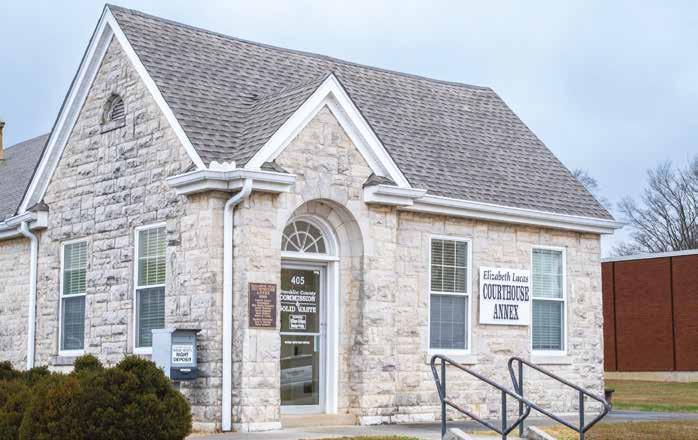 By Alison James alison.james@franklincountytimes.com
By Alison James alison.james@franklincountytimes.com
According to a placard at the annex, Elizabeth Lucas was born, reared and lived her entire life in Franklin County. At the age of 14, in 1922, she began working after school and on Saturdays for the Franklin County probate office, where she continued to work until her death, Aug. 23, 1970.
Most of her career she served as chief clerk in the probate office, but for a period of about three weeks at the end of 1956 and into 1957, she took a step up.
Following the death of then-probate judge James Hester, Lucas filled the role on an interim basis – from mid-December 1956, to Jan. 3, 1957.
According to a Dec. 20, 1956, Franklin County Times article, at a “Sunday morning conference at the home of the late Probate Judge James F. Hester … his family called for appointment of Mrs. Elizabeth Lucas, chief clerk.” However, Lucas served until T.E. Farned assumed the role by governor appointment.
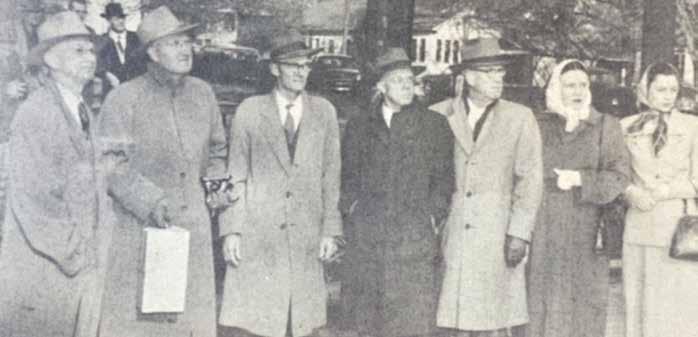
February 8, 2002, the courthouse annex was named in her honor. It was the first act of the county commission in their first meeting in the new space. In addition to honoring her service to the probate judge office, the memorial is also a nod to her being the mother of Bill Lucas, who was at that time Colonial Bank president; the building formerly housed the Colonial Bank.
According to the annex placard, Lucas was the oldest of seven children of John and Annie Wood. She married William G. Lucas, and they had three children: Emma Lucas Kingston, Ruth Lucas Grissom and the aforementioned Bill Lucas.
Lucas was the oldest of seven children of John and Annie Wood. She married William G. Lucas, and they had three children: Emma Lucas Kingston, Ruth Lucas Grissom and the aforementioned Bill Lucas.PHOTO BY ALISON JAMES The Elizabeth Lucas Courthouse Annex houses county commission offices and meeting room for Franklin County. The building, located on Jackson Avenue across from the county courthouse in downtown Russellville, became the commission’s home Feb. 8, 2002, after months of renovation. FILE PHOTO In this photo reprinted in the 1969 Franklin County Times Sesquicentennial Edition, Elizabeth Lucas (second from right) and other courthouse personnel – Foss Weatherford, James Hester, Martin Golden, James Orman, Ed Underwood and Evelyn Evans – look on as the courthouse burns in January 1953. By Alison James alison.james@franklincountytimes.com
The Russellville High School Class of 1988 Chucky Mullins Scholarship Committee has remained dedicated to preserving the memory of the Russellville legend who was injured while playing defensive back for Ole Miss during a tackle of Vanderbilt fullback Brad Gaines Oct. 29, 1989. The incident left him paralyzed from the neck down, and he lived until May 6, 1991.
Of course, few who remember Chucky Mullins could forget him. His story has been the subject of movies/ documentaries, articles, scholarships, books and more.
“He came through our programs –all of our rec programs – and was the nicest kid even when he was young. Very polite,” said Jackie Bradford, remembering Mullins from his time as Russellville Parks & Rec director. “The Chucky Mullins Community Center was
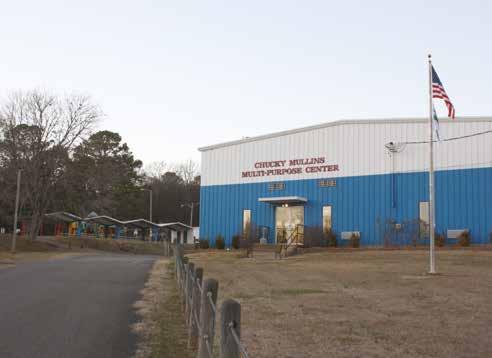
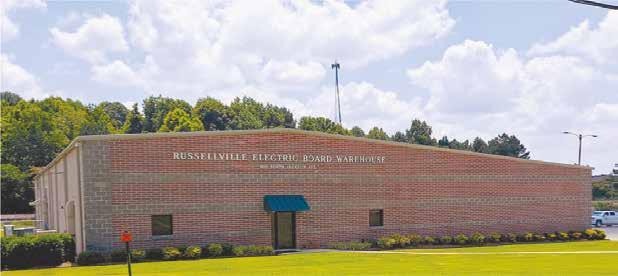
named after him … Everybody around here knows who he was, so that was a good deal.”
The Mullins center hosts youth sports and is also available as a rental for community and private events. “Without it we just couldn’t have basketball leagues, and we also play volleyball,” noted current Parks & Rec director Donnie Flanagan. “It’s very beneficial to have two gyms in Russellville for boys and girls to plays sports in … We host a lot of programs for the children.” Flanagan said probably 700 or more children in the City of Russellville play one or more of the youth sports offered by the department –like Bradford’s 8-year-old granddaughter, who has played at both the Mullins and Bishop centers.
Although Bradford remembers Mullins from rec basketball – “He was good basketball player even when he was so young” – he also got to see the young
See MULLINS, Page 22
man in action on the football field, as he used to keep stats for Russellville games. “I got to record some of the tackles that he made when he was playing for Russellville.”
Mullins is remembered not only for his love and skill for playing football but also for his highly positive and encouraging attitude and the great love and compassion he showed for others.
As recounted in a 2009 Franklin County Times article, «If you had the outlook he did, this world would not have any problems,» said Russellville offensive line coach Ted Ikerd. «You wanted Chucky as a friend.»
Mullins faced adversity through out his life, but he had an ability to keep those around him feeling their best even when he was at his worst.

Carver Phillips and his wife Karen became Mullins’ foster parents following the death of his mother. Mullins made a quick impression on his new caregivers.
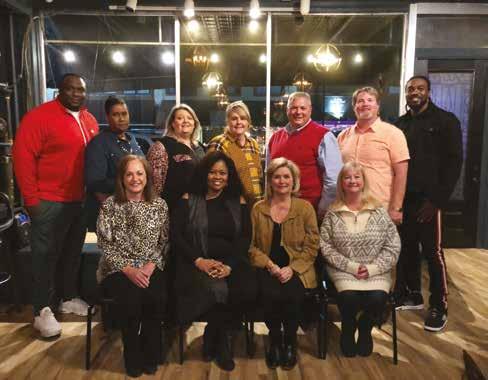
«He was awesome,» Carver Phillips said. «He was the type of kid who would do whatever you taught him to the best of his abilities.»
That included football.
Former Russelville head coach Don Cox said he never saw a player who loved football the way Mullins did. He even loved to practice, which Cox admits is a rare trait in players.
«He was the most fearless player I’ve coached,» Cox said. «He would run through a brick wall to make a tackle. We had to hold him back to keep him from hurting his teammates.»
According to his bio at olemisssports. com, Mullins earned All-Conference, AllArea and All-State honors in football as a junior and senior at Russellville. He was team captain and most valuable player. He earned three letters – in football, basketball and baseball.
A bronze bust at Ole Miss honors Mullins’ memory, installed atop a brick pillar emblazoned with his motto: “Never quit.” Each year the college presents the Chucky Mullins Courage Award to a player who “embodies the spirit of Mullins — courage, leadership, perseverance and determination.” His jersey number, 38, was retired in his honor.
“Chucky’s battle with his physical disability and his undefeatable spirit changed the University of Mississippi,” notes his Ole Miss bio. “For months after the tragic accident, Chucky endured the grueling challenges of rehabilitation. During the difficult time, Chucky’s gritty determination and positive spirit touched the lives of literally hundreds of people. More than a million dollars was raised for the Chucky Mullins Trust Fund. He was visited in the hospital and
later at home by such stars as Walter Payton, Janet Jackson and President George Bush.
“Chucky’s accident and his unbroken
spirit transcended football. The people of Mississippi, the South and the entire United States rallied around this remarkable young man.”

 By Alison James alison.james@franklincountytimes.com
By Alison James alison.james@franklincountytimes.com

Born and raised in Phil Campbell, Charles Parrish’s rise to the Franklin County superintendent’s office was a relatively quick one, and his service in the role left a lasting impact on the county.
Parrish served as superintendent for two terms, from 1960-1968, during which time he was committed to excellence in the Franklin County Schools system.
“One of the things Daddy was most proud of was that for the first time in the county, there was a class established for hard-of-hearing students,” noted daughter Diane Hogan. “Another thing he was very proud of is that all of the county high schools were accredited during his administration.”

Other achievements included the construction of an agriculture and home economics building at Red Bay; the addition of a vocational building and gym at Vina, as well as a library; and gym renovations and a new football stadium at Phil Campbell – the latter of which bears his name to this day.
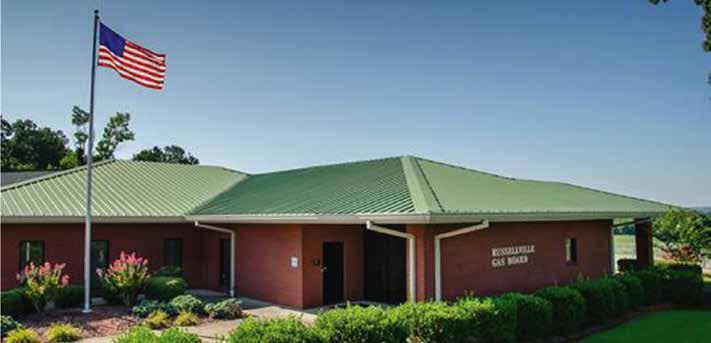
“It makes me proud,” said Hogan, adding she often drives by the stadium to reflect on precious memories of her father. “It means a lot to our family. It really does.”
Hogan said Parrish was a student at Phil Campbell High School himself, as was the girl who would later become his wife, Virginia Mays. Although Parrish was drafted into World War II while in high school, he returned to Phil Campbell to complete his education after his military service, and he continued on to Jackson State Teachers College on the GI bill.
He taught for a few years at Lynn – PE and history, Hogan thinks – before returning to Franklin County as principal of Rockwood School. Hogan was a student at Rockwood while her father was principal. He was soon elected to the superintendent’s chair.
“He loved all the county schools, and he helped all the kids throughout the county. He just loved working with children,” Hogan said. “He was such a good person. He tried to do good for the church and the schools in this county. He meant a lot to the schools here and the boys and girls he came into contact with.”
Parrish was an elder at the Isbell church of Christ and was also involved in civic groups like the Civilians. Hogan said he also loved sports and enjoyed fishing, and he was a
big Alabama fan. Above it all, however, “the church and his family always came first.”
After his service as superintendent, Parrish continued his career in the Franklin County Schools system, managing federal programs. He passed away in March 1981 after several years battling cancer that spread from his lungs throughout his body.
“He suffered a painful fight with it, but he kept fighting it,” Hogan said. “He never complained. He never said why me. I always admired his attitude.”
Hogan and sister Harriet Miller both followed in their father’s footsteps as school teachers. Hogan has two sons, and Miller has one son and one daughter. Hogan said it means a lot to their family to have a visible reminder of everything Parrish meant to his family and his community. Miller said their dad was thrilled and honored by the move to name the stadium after him.
“You don’t want people to forget,” said, Hogan “how much somebody loved the school system and how hard they worked.”
As recounted in an article in the Franklin County Times Sesquicentennial special section, Russellville was incorporated in 1819. It was first governed by a board of trustees, elected every year. In that article, Maj. William Russell is referred to as simply “one of the pioneers” of the community. The good major is the namesake of Russellville, credited with founding the community.
“Place Names in Alabama,” by Virginia O. Foscue, describes Russellville like this: “Settled in 1815 by William Russell, chief scout for Andrew Jackson in the Creek Indian War of 1813-14. Area first known as Russell’s Valley. In 1819 the town was inc. as RUSSELLVILLE.”
As recorded by historical documents, it was when Gen. Andrew Jackson was cutting the Jackson Highway to New Orleans, through Franklin County, Russell – one of Jackson’s most trusted scouts – discovered the desirability of this region. “Major Russell saw that it was attractive territory. When the road was completed he came back and built the first pioneer cabin two and a half miles east of the present site of Russellville.
The section around the present site of Russellville was called Russell Valley in honor of the man who built the first pioneer cabin.”


He also built a trading post in the same area. As noted by “The Heritage of Franklin County, Alabama,” other pioneers built their log cabins in proximity to the trading post, and native Americans would visit to trade furs for guns, knives and axes. As the town began to grow up, however, Russell apparently felt stifled by the influx of other people. He moved out to Newburg, where he later died and is now buried.
“Meanwhile,” the sesquicentennial article notes, “sickness, probably malaria, struck the little settlement he had left behind, and the townsfolk moved westward to the present location of Russellville.”
A 2005 Franklin County Times article quotes descendant Richard Wagner as saying Russell likely chose the area to settle because of the amazing scenery – which is echoed in other historical accounts about Russellville’s founding. “Newburg’s scenery was the pick of the lay of the land,” said Wagner, who had spent a considerable amount of time researching his family history. “He liked a spot on a high lay of a creek, flat ground,
farmland and some bottomland and hills.”
Before his death, Russell “saw the settlement become the most important town and the county seat of a newly created Franklin County in a newly organized area,” according to “The Heritage of Franklin County, Alabama.” Russellville was incorporated Nov. 27, 1819 – three weeks before Alabama became a state.
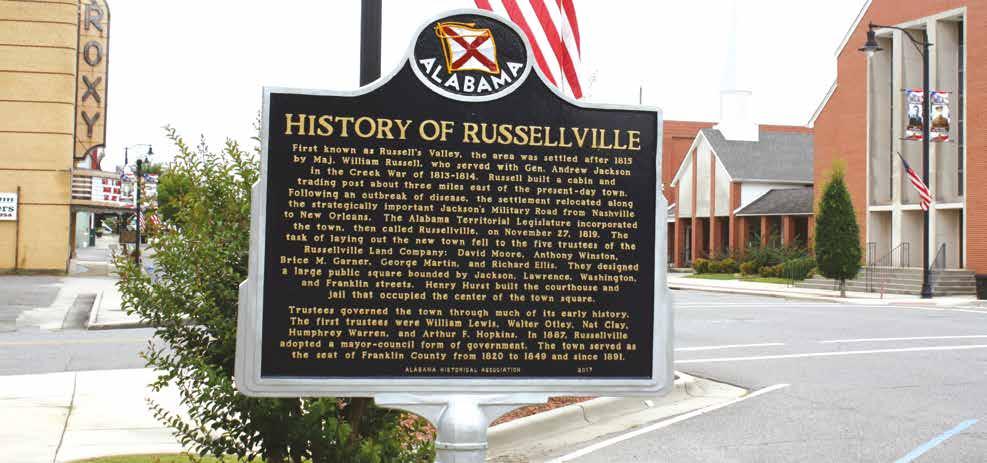
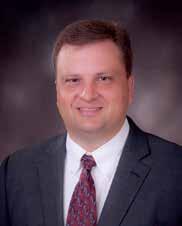
In “The Heritage of Franklin County, Alabama,” the War Department record refers to Russell as “captain of a company of mounted spies, Tennessee, from October 4, 1813, to April 4, 1814” and as a “major of a separate battalion of Tennessee mounted riflemen from September 28, 1814, to March 27, 1815.”

According to a letter transcribed in 1932 and reprinted in part in the same 2005 FCT article, Jackson held precious memories of Russell and their service together. He wrote to Russell’s son that, “My memory for your father and his noble deeds in War is as fresh as it was when he was so gallantly loading on his company to battle and to victory – I never can forget him … and the arduous and long, and gallant service of your father throughout the whole War.”
In July 2007 the city found another way to preserve its history with the addition of a historical marker downtown, at the intersection of North Jackson Avenue and Lawrence Street East, thanks to the effort of longtime resident and author Homer Grissom with the aid of Franklin County Archives director Chris Ozbirn. The marker, and other historical markers in the city, note Russell’s importance to the city’s history.
According to an obituary noticed printed in The Tuscumbian, Russell “died at his residence in this county, on Wednesday the 16th inst. Major Wm Russell aged about 63 years. In the demise of this man, Society has lost an ornament – the poor of his neighborhood, a kind benefactor – the survivors of his family, an indulgent protector, and his country a patriot. On our western frontier from his boyhood, the opponent, but never an unrelenting victor – An officer in the late Creek and Seminole wars, he had the friendship of his commander and the love and respect of his men. These best exhibit his character as a soldier.»
Russell was laid to rest in the Denton Hollow Cemetery in East Franklin. His headstone notes his military service and death date of Feb. 16, 1825.




In addition to Hal Kirby Jr. Park and the John Blackwell Sports Complex, one other Russellville ballfield that carries a «name» is the Tom Strange Field. It is located between Leisure Creations and the Ralph Bishop Community Center. Tom Strange served as a councilman in the 1980s.
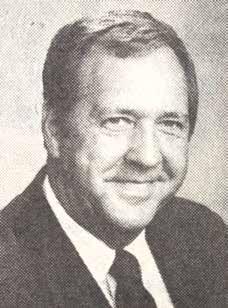

“Mayor Bishop assigned him to be with the Parks and Rec Department, so he was my liaison between the mayor and the council,” explained Jackie Bradford, who was Parks and Rec director at the time.
“That field – we had already got some grants to build it, but he was the one who said ‘Hurry up. Get it done,’” Bradford added with a laugh. “He just wanted the field where they could start using it.”
Bradford said following Strange’s death, the city named the field for him.
“He was a city councilman and a wellknown figure throughout the county,” Bradford said. “He was a good friend of mine. I hated to lose him. I think about him all the time – especially when I see his name on that field.”
Current Parks & Rec director Donnie Flanagan said having multiple ballfields is key to youth sports programming for Russellville. The city offers both baseball and softball, as well as T-ball, serving ages 3-12.
We would be honored to assist you in prearranging your services or in your time of need.


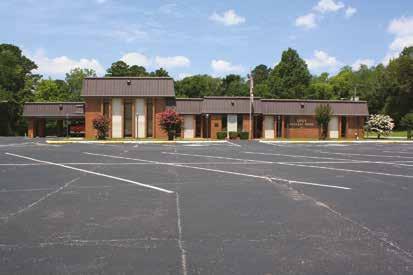 BY FAILING
BY FAILING
Did you know Franklin County is named after Benjamin Franklin? Franklin County is a great place to live, work, and play because of its best asset: the people. Together, we can prepare for tomorrow by continuing to better the quality of life for the residents and businesses in our communities.
Proudly serving you, Senator Larry Stutts


David Tiffin was taken completely by surprise when, at an April 2006 home game, the Red Bay softball team named their field for him.
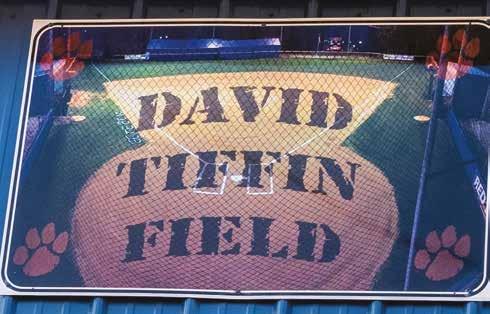
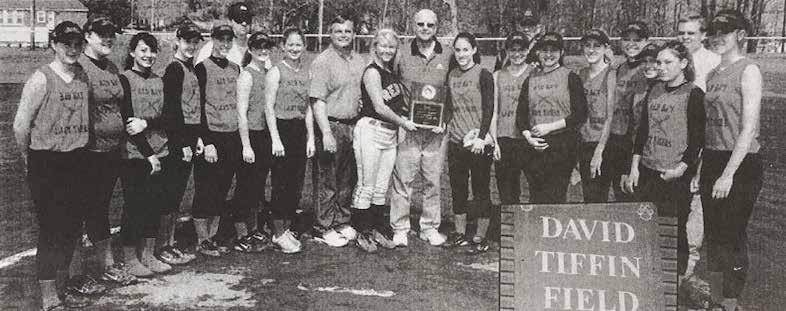
“I was quite honored, to tell you the truth about it. I was not expecting that,” Tiffin said.
Tiffin was responsible for purchasing the land that now serves as the site of the softball field. Although he at one point envisioned it for the expansion of Dixie Youth baseball, he soon saw Red Bay High School’s need for a softball facility and donated it to the school – after getting the land improved.
“I was honored. It was nice to receive that recognition – but I didn’t do a whole lot, in my opinion, to deserve
it,” said Tiffin, a former mayor and city councilman and longtime supporter of Red Bay athletics.
Although Tiffin’s feelings about his involvement are humble, Alan Hardin had a different idea about what recognition Tiffin deserved. Hardin, whose daughter grew up playing ball with Tiffin’s granddaughter, instigated getting the field named for Tiffin.
“If it wasn’t for him, it wouldn’t be there,” said Hardin, who recalls the piece of property was “nothing but a gulley” when Tiffin first purchased it.
Hardin along with Tiffin’s son-in-law Richard Hammock and several other softball dads had set to work rehabbing the school’s field when their daughters advanced to playing junior high ball. Once the field had been upgraded, Hardin thought of Tiffin and a desire to “give him the recognition I thought he deserved because

he put a lot of money into that field.”
“I just thought it would be nice to recognize David because a lot of people had forgotten,” Hardin explained.
Tiffin’s granddaughters were a crucial part of the field’s dedication to him, with Alyssa Horton giving him a ball to throw the first pitch and Holly Hammock catching it.
“It’s a nice facility,” said Tiffin – though still discounting the part he played, he joked, “I don’t think my name is mentioned too much.”
Mayor Charlene Fancher said efforts like Tiffin’s are crucial and deserve to be honored especially because of the cascading effect they can have.
“It makes others step up to the plate,” Fancher explained. “I think it’s important to take note of our forefathers –people who have been significant and been generous in supporting a city … That’s how a city continues to grow.”


















Since 2002 the A.W. Todd Centre has stood has a testament to the lifelong efforts of its namesake – Arvel Woodfin Todd – to champion the needs of his native county.

As recorded by the Franklin County Chamber of Commerce, the A.W. Todd Centre Building Authority was formed in 1998 to plan the creation of the Centre. Construction was funded by $400,000 secured by Todd in 1994; $200,000 secured by one time senator Roger Bedford; $200,000 appropriated by Commissioner of Agriculture Charles Bishop; $134,000 in a no-interest loan from the Farmer’s Market Association; and other funds set aside by the city of Russellville and the Franklin County Commission.
So who was the man who inspired such a building to be constructed and named to honor his legacy?
Born in Belgreen in 1915, Todd was a passionate champion of farming and agriculture in Alabama. He earned his agricultural science degree in 1940 from Alabama Polytechnic Institute – now Auburn University – and after a few years in business and entrepreneurship, he took his first step into the political arena, elected to the Alabama Senate in 1950.
It was his career and achievements in politics that perhaps distinguish him the most. He was also elected to the state House of Representatives and served 12 years as Alabama Commissioner of Agriculture and Industries – the youngest person to be nominated and elected to the position and the only person in Alabama history to have served three terms in the office, according to a 2002 Franklin County Times special section in his
honor. Before the A.W. Todd Centre in the early 2000s, Todd was also responsible for securing funding for a Coliseum in Russellville, one of six such facilities across the state, with a stateappropriated $50,000 in 1958.

His political career inspired Russellville Mayor David Grissom, who got his own start and interest in politics sparked by his activities at Alabama Boys State while in high school. “Mr. Todd was a customer of ours at the car wash, and I used to wash his car often,” Grissom explained. At Boys State, “you can run for offices, from governor on down. Because of my relationship with Mr. Todd at the car wash on Saturdays, I decided I was going to run for commissioner of agriculture, like Mr. Todd was.”
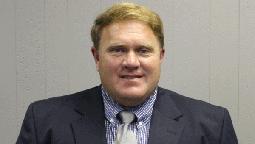
Grissom sought advice from the hometown hero – “He well informed me. I took a lot of notes” – to plan his campaign. “I did not win the election, but I ended up being the assistant commissioner of agriculture,” Grissom said. “That was probably my beginning of being interested in politics.”

Todd has his own experience with a disappointing election result, with an unsuccessful campaign for Alabama governor in 1958. Although he ultimately missed the Democratic nomination, Todd was well supported at home, with huge turnouts at his campaign rallies and 61 percent of the vote in Franklin County. He ran on ideas for industrial growth, an expanded education program and a continuing commitment to agriculture. He pledged himself to “maintaining our Southern way of life,” as record by an FCT article at the time. “We are people of good will, and people of good will can work out their problems, no matter what those problems might be,” Todd is quoted. In another article, “I promise you I will bow my head each morning before entering the executive office and ask our great Creator to give me help in solving the problems of that office in a Christian way.”
Todd passed away in 1996, leaving behind him a long legacy of commitment to his state and to his hometown – one that will not be soon forgot, if only for the sake of the community gathering place that bears his name and bears out his love for Franklin County.
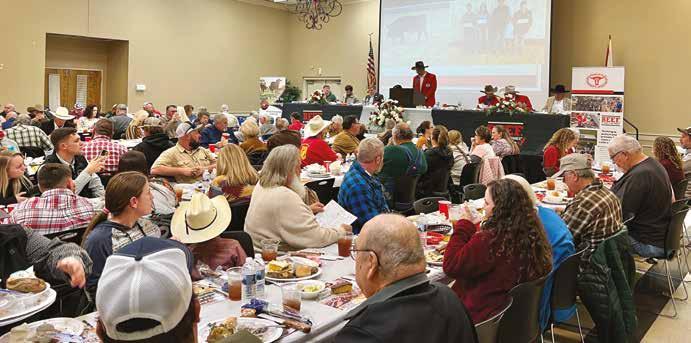
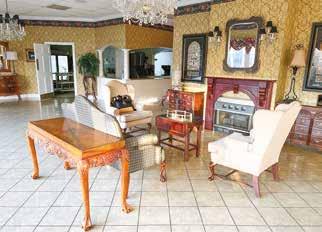
It’s hard to say what Zadoc L. Weatherford is most known for in the City of Red Bay. He came to the community briefly in 1917 before leaving to serve in World War I. When he returned in 1924, he was all in on service to his community – although service to his country had ended with being shot in the arm.
“It took all the muscle of his left arm. They were going to take his arm off, and we wouldn’t let them,” said Billy Bolton. “He showed me his lack of muscle on his left side several times.”
Bolton knew Weatherford well, as a doctor with a long medical practice but also through their mutual affiliation with the Bank of Red Bay – today, Community Spirit Bank. “He called the bank his baby,” said Bolton — a baby Weatherford first committed to in 1926. “He wanted to make sure the bank was taken care of after he was gone and remained an independent bank.”
Weatehrford’s full biography is well documented as an entry in the Encyclopedia of Alabama, and stories, photos and accolades for the man are abundant in Carl Elliott’s “One Hundred Years of Memories: An Oral History of Red Bay.”
The Encyclopedia entry records Weatherford as “a Democratic U.S. Representative from Alabama’s Seventh Congressional District who briefly filled the seat that was left vacant by the sudden death of William B. Bankhead. Earlier in his career, Weatherford was a general medical practitioner and served during World War I in the U.S. Army as a battalion surgeon in France. After being discharged, Weatherford served in various medical positions and in local and state politics.”
Weatherford was born on a farm in Marion County Feb. 4, 1888. He graduated from the University of Tennessee at Memphis in 1914 with a medical degree and for the next two years served as an intern at Saint Joseph’s Hospital in Memphis. He married Ollie F. Barnes of Marion County June 30, 1916.
For his three years of military service, he was awarded a Purple Heart and went on to help fellow veterans as the subdistrict medical officer at the U.S. Veterans’ Bureau in Montgomery.
Back in Red Bay, he served as vice chairman of the Franklin County Democratic Committee from 1933-37 and as president of the Bank of Red Bay beginning in 1938. He was also bank CEO and board chairman and was chairman emeritus when he died.
“He was quite a character, and he loved this community,” said Bolton, who is former president and CEO of the bank and still serves as chairman of the board. He also was co-executor of Weatherford’s estate and helped establish the Weatherford Foundation, following the good doctor’s death in 1983. “He was quite a man. His legacy lives on through the bank, of course. The stock that he owned at that time went into the
Foundation, and then the Foundation sold the stock to our ESOP.”
Weatherford was elected to the Alabama State Senate in 1939 and served until 1944. It was in November 1940 that he was elected to the U.S. Congress to fill the vacancy created by the death of Bankhead, and he served in Congress from Nov. 5 until Jan. 3, 1941, the end of Bankhead’s term in the 76th Congress.
Weatherford served as mayor of Red Bay from 19451948.
Two buildings in the city bear his name, one being the Weatherford Centre. The building was formerly a bowling alley and theatre and sports store. Bolton explained the bank had a mortgage on it, and when it foreclosed on the building, the bank turned it into what it is today, in 1994. “I think he’d be pleased. It serves the people, and he was always for the people of Red Bay,” said Bolton. He recounted that Weatherford used to say, “A frog’s not much of a frog if he don’t holler for his own pond.”
Franklin County Commissioner David Hester is among many who have taken advantage of the

Weatherford Centre and the asset it is for the community. The 200-person banquet room and 30-person garden room, plus community theater, have served many over the decades, from community and civic events to school and church gatherings. The Centre is the home of the Bay Tree Council for the Performing Arts, which stages its shows there, and Hester has attended political events there.
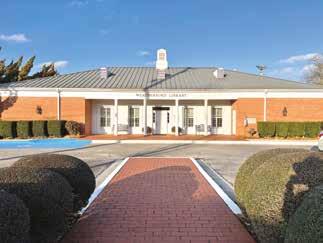

“I remember going and seeing Tommy Tuberville when he was running for office,” Hester said. “The last election, Katie Britt came to the Weatherford Centre as a fundraiser. The Red Bay area did very well for her.”
The other building bearing Weatherford’s name is the public library. Weatherford gave $100,000 to build the library that still serves the community to this day.
“From what I found out, it was actually started by Dr. Dempsey’s wife, Jean Dempsey. She had the heart for books and started a library in that same area, but it was in a house,” Hester said. “They started to outgrow the house and wanted to get the funds up for a library building.”
Doctor, banker, farmer, philanthropist, politician – Red Bay legend was all that and morePHOTOS BY MARÍA CAMP





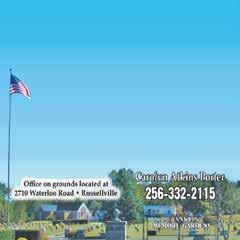

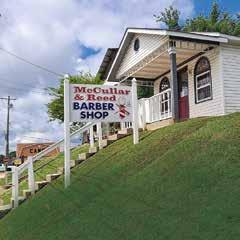
When Dempsey started knocking on doors seeking donations for construction, Weatherford stepped up to the task, donating $100K for the project. The old house was torn down, and the books were housed in Weatherford’s Red Bay Clinic – where many were born at the time, with the lack of a hospital in the community – while the library facility was being built.
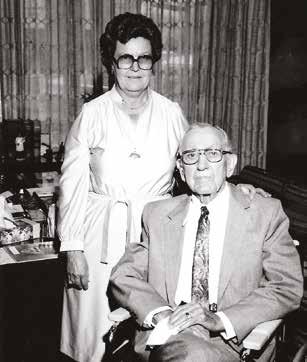
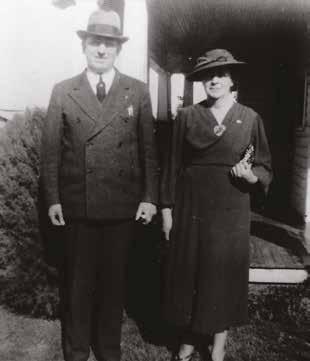
“When you go back 30-40 years ago, a library or a newspaper office was your only two means of a source of information, to gather information on anything of the world,” Hester said. “The library was a very important information source. For him to donate $100,000 like that of his own money – I thought that was a big statement.”
“He wanted to make sure the city had a nice library,” Bolton agreed.
Red Bay Mayor Charlene Fancher said Weatehrford, and all those whose names grace local facilities, were “all people of genuine love for the city, and they expected nothing in return.”
“It’s an honor for those people to have a building or park named after them – a sign of appreciation,” Fancher said, noting it honors their legacy in the community and hopefully is meaningful to their families, to see that recognition of their legacy. “It’s a sign to the family of how that person worked very hard a made a difference in the lives of people. I think that’s outstanding.”
